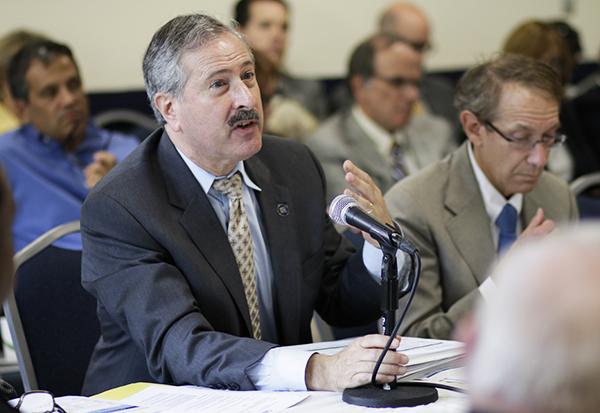The University will create a system for schools to anticipate fluctuations in graduate enrollment up to five years in advance, helping officials better predict how much revenue each school will have.
That new model will improve GW’s ability to anticipate drops or increases in enrollment, and better plan for the impact of changes on the University’s bottom line. And as administrators create a more long-term budgeting system, they will have to factor in enrollment planning, Provost Steven Lerman said at a Faculty Senate meeting this month.
“We are still a very tuition-dependent University, and it’s impossible to think about a five-year budget plan without having the five-year enrollment plan,” he said. “The two are inextricably linked.”
GW is dependent on tuition for about 62 percent of revenue, which is higher than most of its peer schools. Creditors have warned that the reliance on tuition for covering operating costs may not be sustainable for the University, which cannot continue to raise its already high sticker price of more than $60,000.
Administrators have spent the last two years designing the new budget system, which they will use to plan for future costs years down the line. GW plans to roll out the budget model next year.
Last spring, the Faculty Senate called on the University to adopt a new system after raising concerns that GW could not forecast future expenses.
A more far-seeing look will help GW “maintain long-term financial sustainability,” said Vice Provost for Budget and Finance Rene Stewart O’Neal.
“This will help us to meet our objectives of increased transparency, a longer-term planning horizon and better processes for making decisions about strategic investment,” Stewart O’Neal said.
With the new model, schools will receive a larger portion of government subsidies based on research, which GW hopes will encourage professors to do more research.
For the last two years, graduate enrollment has continued to drop, which has left the operating budget without millions of dollars. That has forced the entire University to tighten budgets this year and find ways to create new revenue, such as launching online programs.
Laurie Koehler, senior associate provost for enrollment management, said administrators asked each school to provide details about which programs they could develop at the graduate level. Schools are not required to make projections at the undergraduate level because all undergraduate students are admitted through a central office rather than by individual schools, Koehler said.
Without a system to predict changes in enrollment, schools are left “at the whims of what’s going on,” said Larry Goldstein, the president of the higher education finance consulting company Campus Strategies.
“At a tuition-dependent institution, that’s such a huge source of revenues that if you’re not modeling your enrollment, you won’t know what your revenues are or what financial impacts you’ll experience,” Goldstein said. “Without an enrollment model, you’ll be guessing a lot and caught unaware frequently.”
The University’s current budget system projects costs for each school for one year. The University sets the amount it will take from each school’s revenue before the fiscal year begins.
Jean Johnson, dean of the School of Nursing, said she planned out enrollment five years in advance when the school was part of the University’s medical center. It’s a difficult task, she said, but it forces schools to evaluate their priorities early.
She added that schools need to be able to reevaluate between their plans regularly.
“We ended up being relatively accurate, except for the fact that it didn’t factor in new programs and activities that might have occurred in year three, but there’s a way to finance new programs outside of an operations budget, too,” Johnson said.
Eric Sickler, the vice president for client services at the higher education consulting firm Stamats, said enrollment models have become more necessary as students apply to more schools across the country and make it more difficult for schools to predict where they will enroll.
“If we don’t have models to create scenarios with, we are really not in a good place to predict needs that would provide for our students,” Sickler said. “It would give administrators and faculty the opportunity to create a number of scenarios depending on how the recruitment season works out for them and then anticipate opportunities.”
Sickler said models could show details like graduation rates, demographic or census data, and the programs students pick once they’re enrolled in a school. GW could adjust its system in the future and make it more reliable, he said.
Lynn Goldman, dean of the Milken Institute School of Public Health, said the school could probably project its enrollment five years out, but it would be challenging. Still, she said she believed the schools need longer-term budget systems.
“I think that the forecasting for graduate enrollment has been difficult the last few years. We haven’t been good at it, and I’m not sure who has,” she said. “I think a five-year budget five years ago would have been far more optimistic about enrollment in our graduate program.”








